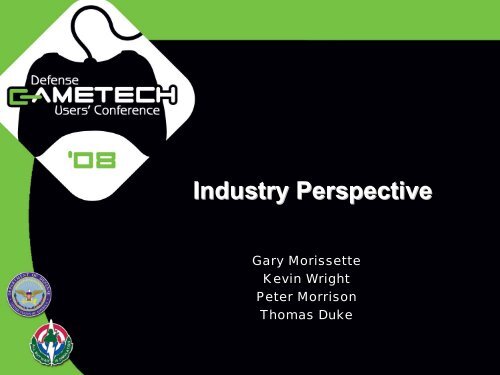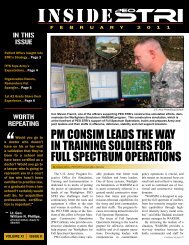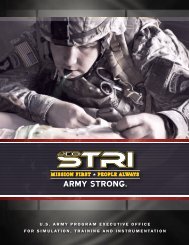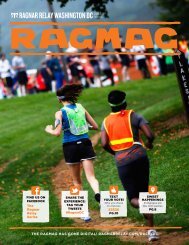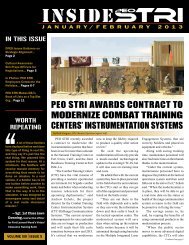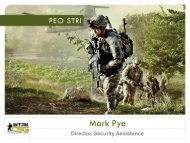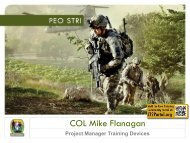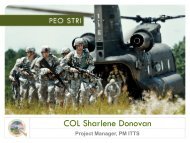Industry Perspective - PEO STRI - U.S. Army
Industry Perspective - PEO STRI - U.S. Army
Industry Perspective - PEO STRI - U.S. Army
You also want an ePaper? Increase the reach of your titles
YUMPU automatically turns print PDFs into web optimized ePapers that Google loves.
©MÄK Technologies, Inc.<br />
<strong>Industry</strong> <strong>Perspective</strong><br />
Gary Morissette<br />
Kevin Wright<br />
Peter Morrison<br />
Thomas Duke
©MÄK Technologies, Inc.<br />
Garry Morissette<br />
MAK Technologies
©MÄK Technologies, Inc.<br />
QuickStrike-based Training System for<br />
ASOC Staff Training
©MÄK Technologies, Inc.<br />
Company Overview<br />
Founded in 1990; Based in Cambridge, MA<br />
A leading COTS software vendor of<br />
distributed networked simulation products<br />
Utilized our own own products in creating<br />
desktop training simulations (“immersive<br />
learning environments”) for military staff<br />
training<br />
Representatives in 30 countries
©MÄK Technologies, Inc.<br />
MÄK K Products<br />
Link<br />
VR-Link®<br />
MÄK RTI<br />
MÄK Gateway<br />
VR-Exchange<br />
Simulate<br />
Visualize<br />
VR-Forces®<br />
MÄK Stealth/StealthXR<br />
MÄK Plan View Display<br />
MÄK Data Logger
©MÄK Technologies, Inc.<br />
MÄK's Trainer Business<br />
Desktop Training Simulations<br />
Tactical Staff Trainers<br />
Quickstrike (Air Force)<br />
MAGTF-XXI (Marines)<br />
Battle Command (<strong>Army</strong>)<br />
Operational Cognitive Readiness Trainers<br />
“CFACC Ace”
©MÄK Technologies, Inc.<br />
MÄK's Trainer Business<br />
Training Simulation Interoperability<br />
Products<br />
Game-Link (Unreal with DIS / HLA)<br />
C2PC Gateway (C2PC with DIS / HLA)<br />
Other “adapters” / “gateways”…<br />
Training Simulation R&D<br />
ADL applications (“experiential learning”)<br />
DARWARS<br />
HLA / SCORM Integration<br />
Joint ADL Co-Lab prototypes
©MÄK Technologies, Inc.<br />
Background:<br />
MÄK's Tactical Staff Trainers<br />
Created to help develop military staff planning and<br />
decision-making / cognitive skills<br />
Built upon MÄK's VR Forces plus other MÄK<br />
products including PVD and Data Logger<br />
Desktop Training / Virtual Reality (VR) simulations<br />
with “just enough” fidelity…
©MÄK Technologies, Inc.<br />
QuickStrike<br />
Created for AFRL Mesa to develop Time-Sensitive<br />
Targeting (TST), “dynamic targeting” cognitive skills<br />
Adopted for use by the 111 th ASOC as the basis for<br />
a mission qualification training and real-world<br />
rehearsal (pre-deployment) training system<br />
Currently being fielded to five other USAF ASOC<br />
units worldwide (funded by ACC)<br />
Uses training objective focused scenarios to<br />
achieve task and process competency<br />
Simulates friendly, hostile, and neutral land,<br />
maritime, and air objects and their interactions
©MÄK Technologies, Inc.<br />
QuickStrike (con’t)<br />
Easy to learn user interface<br />
Simple configuration and scenario generation<br />
Simulation runs from 1 - 10X real time<br />
Uses real map data<br />
Flexible Event Editor… “MSEL” dev / mgmt<br />
Interoperable with C4I systems (using MAK VR<br />
Exchange), including C2PC<br />
Interoperability with JADOCS, TBMCS, and other<br />
systems is under investigation…<br />
DMO (DIS / HLA) compliant… Internet compatible
Scenario Events List<br />
©MÄK Technologies, Inc.
©MÄK Technologies, Inc.<br />
ASOC Ops Floor Training Configuration<br />
COP<br />
Stealth 3D<br />
Viewer / UAV<br />
emulation<br />
SOF Roleplayer<br />
and OC<br />
Fires Roleplayer<br />
and OC<br />
V<br />
O<br />
I<br />
P<br />
FDO<br />
PRC 117f<br />
MIRC MIRC MIRC<br />
V<br />
O<br />
I<br />
P<br />
V<br />
O<br />
I<br />
P<br />
FDT INTEL<br />
MIRC<br />
V<br />
O<br />
I<br />
P<br />
MIRC<br />
V<br />
O<br />
I<br />
P<br />
Roleplayers<br />
JTAC<br />
PRC 117f<br />
RC – N, S, E, W<br />
COP<br />
Alternate Location<br />
V<br />
O<br />
I<br />
P<br />
V<br />
O<br />
I<br />
P<br />
Event<br />
Editor<br />
QuickStrike<br />
Facilitator and<br />
CAOC role player<br />
Projector<br />
QuickStrike<br />
Puckster
©MÄK Technologies, Inc.<br />
Garry Morissette<br />
MÄK K Technologies<br />
68 Moulton Street<br />
Cambridge, MA 02178<br />
(617) 876-8085 8085 x111<br />
gm@mak.com
©MÄK Technologies, Inc.<br />
Kevin Wright<br />
Dynamics Research<br />
Coporation
Guidance from the Chief of Staff<br />
of the <strong>Army</strong><br />
Explore the value of employing<br />
Computer Off The Shelf (COTS)<br />
software solutions to enhance<br />
virtual training as a cost effective<br />
solution to fill gaps in L/V/C<br />
capabilities<br />
Project<br />
• ARI Proof of concept for COTS in support of<br />
training in the Maneuver Captains Career<br />
Course at Fort Benning, GA.<br />
• Generate two multiplayer interactive<br />
scenarios to supplement training in real-time<br />
decision making/mission execution for MC3.<br />
Media<br />
• DARWARS Ambush!<br />
COTS software modified for <strong>PEO</strong> <strong>STRI</strong> by DARPA
Missions/Scenarios<br />
Stryker Company Stability Operations<br />
•Conduct a Tactical Road March<br />
•Conduct a Cordon and Search in a Built-up Area<br />
•Control Civil Disturbance Operations<br />
•Establish Checkpoints and or Roadblocks
Rating Instruments<br />
Instructional Effectiveness<br />
• Assess both process (how the game was used in an instructional setting) and<br />
outcomes (whether students, with instructor supervision and the game as a means,<br />
achieved training objectives).<br />
• Evaluated using the <strong>Army</strong>’s T, P, and U criteria (T = Trained, P = Needs<br />
Practice/Partially Trained, U = Untrained/Unsatisfactory).<br />
• GO/NO GO used to evaluate student performance of subtasks.<br />
• Identified tasks that were required by the mission but were not trained because of<br />
flaws in our scenario design or because of inherent limitations in DARWARS Ambush!.<br />
Student Decision Making<br />
• Important aspect of previous ARI research<br />
• Related tactical outcomes to leader decisions<br />
• Objective criteria to assess decisions the student leaders and company commanders<br />
made (or failed to make) and to evaluate whether outcomes were positive or negative<br />
17
Stryker Company Scenario Troops Available<br />
3<br />
I<br />
A 4-23<br />
…<br />
CO CDR, ICV + CA<br />
& ENGR/EOD<br />
.<br />
1 CA 1/B/478<br />
SNIPER<br />
X2 (placed forward south of OBJ<br />
area)<br />
4<br />
4<br />
1<br />
3<br />
…<br />
A/4-23<br />
A/4-23<br />
1 ICV, PL, 3 SL DISMTS/GNRs<br />
1 ICV, PL, 3 SL DISMTS/GNRs<br />
MTR<br />
A/4-23<br />
ICV(1) w 120mm<br />
(replicated) FIST DVR<br />
1<br />
…<br />
4<br />
2<br />
…<br />
A/4-23<br />
1 ICV, PL, 3 SL DISMTS/GNRs<br />
2 x AH-64D<br />
X2 + AI tethered<br />
AH-64<br />
2<br />
6<br />
4<br />
4<br />
1<br />
MGS<br />
…<br />
GSF<br />
A/4-23<br />
3 MGS DVRs + 3 GNRS<br />
(AT Variant as of now)<br />
PL + 3 SL (M113)<br />
5<br />
25<br />
TOTAL: 30<br />
18
Enemy<br />
Stryker Scenario<br />
IED TM<br />
2-3 men<br />
IED TM<br />
2-3 men<br />
Bomb Maker<br />
(VB)IED<br />
(any player 2<br />
can operate)<br />
Players<br />
C2<br />
NPC<br />
$<br />
Financier<br />
Suicide<br />
-Bomber<br />
-2x Spotter<br />
Bomb Maker<br />
Vest<br />
(female 1<br />
sniper/bomber)<br />
-Planner<br />
-Recruiter<br />
1<br />
OPFOR CDR<br />
Attack C2<br />
-Planner<br />
-Recruiter<br />
3<br />
Leaders w/AK-74 &<br />
RPG<br />
Demonstration<br />
- Recruiter<br />
-2-3 man<br />
Mortar C2<br />
-Planner<br />
-Recruiter<br />
2x man TM<br />
3 “OP”s w/ pistols (Replicated by GL)<br />
AK-47<br />
RPG-7<br />
30-50<br />
x1<br />
2<br />
2x man TM<br />
TOTAL: 10 Players<br />
2 Sniper/Bomber (IED)<br />
(female is suicide bomber) 19
Civilians & Non lethal scripted and<br />
embedded in Stryker Scenario<br />
Bystanders/<br />
Urban Backdrop<br />
Cordon Challenges<br />
(depiction of good samaritan<br />
turning in RPG)<br />
Demonstrators<br />
20
Terrain Generation<br />
Goal: Geospatially accurate terrain with corresponding UMGS<br />
grid overlay<br />
Corel<br />
Process: PSP<br />
USGS<br />
DEMS<br />
Wilbur<br />
Precise<br />
Digital<br />
Elevation<br />
Data<br />
Crop &<br />
Scale<br />
WRPtool<br />
DARWARS<br />
Mission Editor<br />
Reformat<br />
Textures<br />
Vegetation<br />
Buildings<br />
Roads<br />
Forces<br />
Effects
Virtual<br />
Columbus, GA<br />
22
Virtual<br />
Columbus,<br />
GA<br />
North and west<br />
side of Republican<br />
HQs and SE Block<br />
23
Lessons Learned – DARWARS Ambush!<br />
• VIRTUAL TRAINING - Viable tool for integration into L/V/C training strategy<br />
• SCOPE - Maximum value at Platoon/Squad Level but useful for discrete tasks<br />
and(or) mission sub-sets for complex operations at company team level<br />
• SYSTEM REQUIREMENTS - Requires high functioning computer systems<br />
optimized for gaming to realize full value of the simulation<br />
• C2 – Trainer remains indispensable: training planning and management,<br />
exercise control, role playing, enforce training objectives and conduct AARs<br />
• TERRAIN - Ability to generate a wide variety geospecific terrain rapidly,<br />
enhances training value of the simulation<br />
• LIMITATIONS – Generally, game outcomes matched those one would expect in<br />
real world execution. Capabilities of the simulation are largely limited by the<br />
imagination of the scenario designer<br />
24
Questions<br />
25
Peter Morrison<br />
Bohemia Interactive Australia
<strong>Industry</strong> <strong>Perspective</strong><br />
(from a small, independent, Australian-based<br />
game development company)<br />
Peter Morrison<br />
Managing Director<br />
Bohemia Interactive Australia
Overview<br />
• BI is a game development<br />
partnership<br />
– Operation Flashpoint (DARWARS<br />
Ambush!)<br />
– Virtual Battlespace 1<br />
– Virtual Battlespace 2<br />
• Two independent studios<br />
– BIS (CZ): Core engine, entertainment<br />
– BIA (Australia): ‘Serious’ games<br />
• BIA Primary Focus: VBS<br />
– Human in the loop, tactical, combined<br />
arms training, federated as required<br />
– One participant per desktop computer<br />
for networked collective training<br />
– A robust mission rehearsal capability
Evolution of a Game Engine<br />
2008<br />
ArmA<br />
(2006)<br />
Capability<br />
enhancements<br />
for ‘serious’<br />
users<br />
VBS2<br />
(2007)<br />
OFP<br />
(2001) VBS1 /<br />
Ambush!<br />
(2003)<br />
Entertainment<br />
Game Engine + Tools<br />
Training and Analysis
From Game to Training Tool<br />
• Interoperability<br />
– HLA and DIS compliance to maximize flexibility<br />
– Smart middleware – LVC Game – supports all standards<br />
• Rapid Terrain Import (< 1 day)<br />
– Supports interoperability<br />
• Run-Time Authoring<br />
– Rapid, real-time scenario and terrain development<br />
• After-Action Review<br />
– Supports training and analysis (bookmarks!)<br />
• Rapid development<br />
– End-user development of content (3D models and terrain)
From Game to Training Tool<br />
• End user rapid development is key – keeps cost down!<br />
– Content (3D models and terrain)<br />
– Functionality (scripted systems)<br />
• Remember: ‘proprietary’ is necessary for game companies!<br />
– Proprietary != Evil<br />
• Compare total cost of VBS2 vs RealWorld<br />
– VBS2 has very similar capabilities, 1/20 th of the budget, avail now<br />
– The downsides:<br />
• 1) You don’t own VBS2 source code, 2) You have to buy licenses (!)<br />
– The upsides:<br />
• You can do almost anything through VBS2 tools and scripting anyway<br />
• BIA is the most qualified to maintain the game engine, at our cost<br />
• BI philosophy: exploit existing tech, don’t reinvent!<br />
– API for AI integration (AI Implant, Kynapse), TerraVista, Tactical<br />
Language
VBS2 Update: Virtual Training Kit<br />
released<br />
• Engine:<br />
– Destructible buildings<br />
– Deformable terrain<br />
– Breaching (wire, doors,<br />
walls, windows)<br />
– Vehicle recovery<br />
– Thermal imaging<br />
– AAR improvements<br />
(voice replay)<br />
– NBC capability<br />
– Fatigue / suppression<br />
– US <strong>Army</strong> entities<br />
– Multi-core support<br />
– Non-lethal weapons<br />
• Engine Cont’d:<br />
– Reworked inventory<br />
(carry/drop packs etc)<br />
– Hand signals<br />
– MIL STD 525 symbols<br />
• Editor Improvements:<br />
– Configuration editor<br />
– Content management<br />
– Team editor<br />
– Weapon editor<br />
– AI force editor<br />
– VBS2 API<br />
– Import ‘Real World’ 2D<br />
map overlay
VBS2 Update<br />
• TerraVista integration almost to Beta<br />
– TerraVista direct to VBS2<br />
– Also working with TerraSim, others as req<br />
• LVC Game is now bundled with VBS2<br />
– LVC Game is no longer a separate product<br />
– VBS2 will inherently support DIS/HLA<br />
• The VBS2 API will soon be included at<br />
no extra cost<br />
– As used by LVC Game
VBS2 Update<br />
• ALTS (Automatic Language Training System)<br />
integration<br />
– Language and culture training in the networked<br />
VBS2 mission rehearsal environment<br />
– Prototype already completed through the VBS2<br />
Application Scripting Interface (ASI)<br />
• CNR Sim now integrated with VBS2 for radio<br />
comms logging and replay in AAR<br />
– Generic DIS implementation, supports MDV
The Short Term Future<br />
• Continue to open up the platform<br />
– Improve tools<br />
– Support additional formats<br />
– Extend API<br />
• Deliver real time terrain editing<br />
• VTK2 enhancements for USMC<br />
– Engine, HLA/DIS, call for fire<br />
• Urban operations enhancements for UK MoD<br />
• Afghan terrain development for ADF
More Information<br />
VBS2:<br />
Email:<br />
Internet:<br />
sales@vbs2.com<br />
http://www.vbs2.com<br />
VBS Loadmaster Virtual Reality Simulation (LVRS):<br />
Email: sales@vbs2.com<br />
Internet: http://www.vbs2.com<br />
(click on LVRS in ‘Related Projects’)<br />
VBS2 HLA/DIS Gateway (LVC Game), CNR Sim:<br />
Email: sales@calytrix.com<br />
Internet: http://www.calytrix.com<br />
Lasershot:<br />
Email:<br />
Internet:<br />
sales@lasershot.com<br />
http://www.lasershot.com
Thomas Duke<br />
Janus Research Group, Inc.
Simulation Based Training<br />
Overview<br />
JUL Apr 2007 2008<br />
J. Scott<br />
Thomas<br />
Martin<br />
Duke
Overview and Purpose<br />
• Purpose: To demonstrate and discuss several key training technologies<br />
• Simulation Based Training System<br />
– Standalone PC Simulator (VEE v2)<br />
– Nodal Network Simulator<br />
• NIH - StarLite
Standalone PC Simulator<br />
Advantages<br />
•Simulation based training offers advantages over traditional training where equipment<br />
access and/or cost is prohibitive<br />
•Simulation based training offers advantages over more traditional CBT training by providing<br />
a realistic 3D environment that mirrors the real world<br />
Primary Lesson Types<br />
• Familiarize, Acquire, Practice<br />
and Validate<br />
• 3D virtual environment<br />
simulators<br />
• Terminal simulators<br />
• Software simulator<br />
• Knowledge Based - traditional<br />
training material<br />
• Provides IMI level 1-3<br />
simulation
Virtual Environment Engine<br />
• VEE 2.X<br />
–Engine built on top of commercial SW<br />
–Externalized training content<br />
–Interprets XML based training content<br />
<br />
<br />
–Training material is human readable<br />
<br />
<br />
<br />
–Pairs <br />
training content with appropriate<br />
resources<br />
<br />
<br />
<br />
<br />
<br />
<br />
<br />
<br />
<br />
–Allows for significant reuse<br />
–Uses SMEs and instructors for lesson<br />
development<br />
<br />
"Power up the UPS located at A3A17."<br />
"Power on the Uninterruptible Power Supply (UPS) in rack<br />
A3A17 by pressing the \b ON \b0 button located on the front panel."<br />
Military PC Sim Programs and<br />
Projects<br />
• Base Band Node (USARPAC)<br />
• Sectera GSM Phone<br />
• Network Operations Center Vehicular<br />
• Tactical Satellite Terminal (Spring 2005)<br />
• Joint Network Node (SEP 2005, 130hrs)<br />
• BN Command Post Node (SEP 2005,<br />
10hrs)<br />
• Ku Band TACSAT System (SEP 2005,<br />
10hrs)<br />
• Tactical Hub Node (FEB 2006, 120hrs)<br />
• SATCOM HUB NODE (NOV 2006, 80hrs)<br />
• Collaborative Training System Prototype<br />
(AUG 2005)<br />
• A2C2S Operator/Battle Staff Training (FEB<br />
2007, 8hrs)<br />
• Nodal Network Simulator (OCT 2007<br />
Phase 1)<br />
• Marine Corps SWAN (Fall 2007)<br />
• JNN-N Lot 5-7 Maintenance (SEP 2007, )<br />
• JNN-N Lot 8&9 Maintenance (NOV 2007)<br />
• SSS V3 (FEB 2008)
Nodal Network Simulator (NNS)<br />
• A Multi-year development effort to bring a collaborative virtual training<br />
environment that utilizes advanced training technologies and provide<br />
collective student training, supervisor/manager training, as well as<br />
instructor interactions.<br />
• System scales easily to address the following training needs (LAN/WAN)<br />
– Classroom instruction<br />
– Sustainment training<br />
– NET Capstone Exercises<br />
– War gaming simulations<br />
• System reuses components from the PC Simulator which reduces<br />
development time and cost<br />
• The Core of the system is a behavioral model engine which provides full<br />
IMI Level 4 interactivity
Exercise Controller Capabilities<br />
• Exercise Planning<br />
– Student login/Role<br />
management<br />
– Scenario Building/Loading<br />
• Exercise Control<br />
– Exercise pause<br />
– Highlighting of events<br />
• Exercise Monitoring<br />
– Student equipment status<br />
– Objective Monitoring<br />
– Collective and Individual<br />
scenario objective inspection<br />
– Voice and Text<br />
communications
Observer Controller Capabilities<br />
•Exercise Control (Tactical Scope)<br />
–Highlighting of events<br />
•Exercise Monitoring<br />
–Student equipment status<br />
–Objective Monitoring<br />
–Collective and Individual scenario<br />
objective inspection<br />
–Voice and Text communications
Operator/Student Console<br />
• 3D Views<br />
• Software Views<br />
Capabilities<br />
• Simulation Setup and Login -<br />
LAN/WAN<br />
• Exercise Staging and Waiting<br />
Room<br />
• AAR Tools and Reporting<br />
• Voice and Text<br />
Communications
National Institutes of Health<br />
Virtual Environment Laboratory Safety Training<br />
A rich, interactive, three-dimensional teaching environment that uses<br />
a non-traditional approach to engage the user using simulations and<br />
affords a greater opportunity for learning retention. Rather than being<br />
tested on paper or attending verbal lectures, the user trains for eventspecific<br />
scenarios in the environment they'll soon be working and with<br />
the equipment they'll soon be using.<br />
Process<br />
The system development technique used by JANUS allows for the rapid development of training material based on a three dimensional<br />
interactive model of laboratory spaces, and all associated equipment, items, and personnel within the environment. This approach<br />
eliminates the traditional need to develop frames commonly associated with a computer based training system, as well as speeds<br />
development.<br />
Using Instructional Systems Design (ISD), an iterative approach is used to promote flexibility which facilitates either lock-step completion<br />
of phases or concurrent, rapid development processes. The development process for Interactive Multimedia Instruction (IMI) follows<br />
closely with that of the System Approach to Training process and involves the integration of the training material with the Learning<br />
Management system and the production of media for the distribution of the final product.<br />
Three main task areas are required to complete this project:<br />
• Completion of the storyboards to finalize laying out the learning experiences for the training program.<br />
• Development of the software system and virtual environment that will be used to present this training.<br />
• Implementation of the learning experiences within this framework.
Contact Information<br />
Mr. Thomas Duke, Chief Operations Officer<br />
Thomas.Duke@janusresearch.com<br />
Corporate Headquarters<br />
Janus Research Group, Inc<br />
6504 Reservoir Road<br />
Appling, GA 30802<br />
Phone: (706) 309.9300<br />
Fax: (706) 309.9002<br />
For more information about our company or our products and services,<br />
please visit us online at:<br />
www.janusresearch.com


